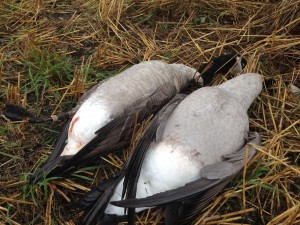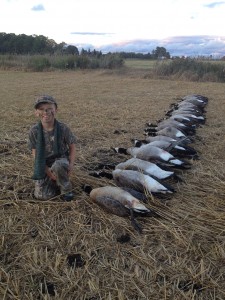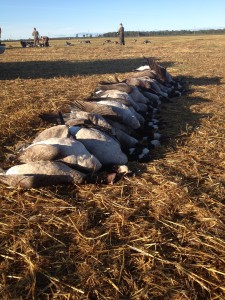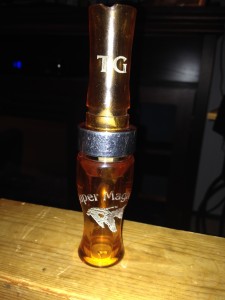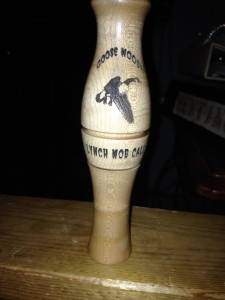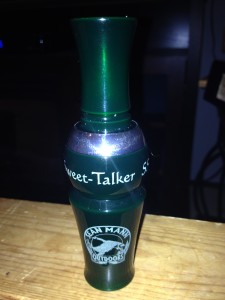I always want to write these things down while they’re happening, but I’m usually too busy being ‘in the moment’. Still, as I find myself in moments like the one I’m in now, bouncing along in turbulence somewhere over Lake Ontario, I think back to that good time had in the camp, and the memories replay like a slideshow across my mind replete with all the sepia-toned embellishments inherent in fond recollections.
There’s a mid-afternoon sun and a cool breeze from the northwest when we pull up to gate the day before the opener, and I don a hoodie before cracking a can of the cold stuff. It tightens my throat and I shiver but not from the early fall air, but from the adrenalin and anticipation.
Trucks begin to roll into what pass for parking spots, haphazardly crooked to the untrained eye, but for the baptized there is a sense of spacing and order.
We lean against railings and tailgates, busting each other’s chops, eating cured meat and crackers, punctuating insults and hunting stories with reckless cackles of laughter. Evening creeps in and still more trucks filter in, until before long twenty grown men are milling around, shaking hands, toasting the gathering, and shouting to be heard.
The next door neighbor, who is also the father-in-law to one of our comrades stops over and we tell him not to expect much in the way of peace and quiet tonight. He mutters a chuckled, unrepeatable curse word and an hour later meanders back home.
Cousin Luke has brought a couple of deep fryers and before long chicken wings are breaded and hit the oil. A liter of Louisiana hot sauce meets a half pound of butter and they become one entity of molten beauty before being poured onto drummies and flatties that glisten crispy and golden after a swim at 350 degrees. In an act of mad-scientist impulse, sweet sticky rib sauce coats another batch of wings, while French fries roll in a turbulent froth of scalding oil.
The night carries on and we carry on with it. 30lbs of wings becomes a pile of cleanly-picked bones in a bowed out aluminum pan. Someone passes me a bottle of Jack Daniels Fire and the peer pressure mounts to have a smash of it, and never one to disappoint my friends in such a benign pastime I oblige them before passing the bottle to my right. The whiskey hits the wings in my belly and I feel happy…in the moment.
Fast forward to sometime after midnight and the remaining men of the camp are all eyeballing the clock, wishing to go to bed but secretly afraid to be the first one to relent, lest his socks get a hole cut in them or he otherwise be deemed ‘soft’. Everyone eventually tires and as if en masse we all find our bunks, while a few stragglers noisily fight the coming of the dawn.
An alarm blares and bleary-eyed goose hunters rue the moments just so shortly put to bed. Teeth are brushed, coffee is slogged back, and gear is checked and double checked. The time has come (too soon for some) to hit the fields and start the day’s work.
We split into two determined groups and make for our spots. The group I take up with decides we have not been punished enough yet and we choose to hand carry a few dozen decoys, along with guns and blind bags the length of two fields. We have permission to, and could just as easily driven out to the spot where we eventually plunk down our bags, but what’s the fun in that? We assemble and place decoys in the dark, and as the first faint rays of sunlight begin to creep in from the east, we find our spots in a deep, grassy ditch to await the morning flight.
I sit pensively with my back against the gentle slope of the embankment, reflecting on the previous night’s decisions and the morning that I hope it will become. Someone shouts down the line that we’re inside of legal light and the sounds of shotguns being loaded floats from station to station. It is the modern era after all, and I confirm the time on my cell phone before texting a couple of guys in the other group. It turns out they have competitors for their field, and are engaged in a debate with other hunters about setup and positioning.
I click the phone off and just listen to the dawn.
In time, and somewhere far off, I eventually hear the whispered calls of Canada geese. I wave a black flag purposefully but with some degree of blind faith that if I can hear the birds, they can see me flagging to them. The calls get closer, and someone hollers down the line.
“Geese in the northwest!” and my eyes and ears triangulate on them just as soon as my brain registers the announcement. There’s a thin string, maybe ten birds in all, stretched out against the horizon and getting unmistakably closer. I put the call to my mouth with my right hand and flag a few more times with my left. The geese wing ever nearer and their chatter is no longer aimless but in response to my calling and the calls of my friends. As they close to about a hundred yards they lock their wings and begin to drift in. They slide to my right and I break into some more excited chatter, trying to coax them back to centre stage. They skirt our right flank, but one goose strays too close to our gun on that end and an expert shot folds the bird while the rest wing away braying and moaning.
The flight has started and we rush to make some daylight adjustments to the decoys, with the hopes that future birds will decoy more readily. With the fakes now in a more appealing semblance of order, we charm a few willing participants to play and as the guns bark, more birds tumble down into the grain stubble.
Geese trade about from all directions, some near and some hopelessly far off, and we shoot and we call and we ultimately decide once a dozen birds are in hand that it is time for breakfast. We have a whole rest of the day to shoot and many of us are both famished and parched. The masochists we are, we choose to hike all the gear out, and my shoulders really feel the added weight of birds in my hands.
Sometimes I don’t even know why those guys have trucks.
We monopolize four full tables in the local diner, and we eat massive breakfasts of bacon, sausage, ham, eggs, and toast, while pitchers of water and carafes of coffee make their way to our tables. We re-live the moments from less than two hours previous and we get an itinerary in order for the rest of the day.
Cleaning and butchering geese. Tidying up the camp. A long nap for some of us. And then back out again to another field for an afternoon shoot…but that last one is literally another story.
Back in the present, the flight has stopped jostling my hands and of course, all of the grievous spelling mistakes and typos will be cleansed before this gets to your screens, my friends. Still, I can assure you that things were fairly bumpy here at 26,000 feet.
Not surprisingly, all it took to smooth out the turbulence was some time taken to myself reminiscing on a weekend that literally gets better and better every year.

